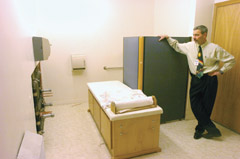|
 |
|
Mark
Ylen/Democrat-Herald Principal
Pat
Weidmann shows the
restroom
that is
being converted to a
hygiene
room at
Calapooia Middle School. |

Calapooia creates
'hygiene' room

By Jennifer
Moody
Albany Democrat-Herald
Calapooia Middle School has begun construction
on a "hygiene" room, the first of its kind in the Albany school
district, to help the school better deal with lice and other health
issues.
"Plumbing's roughed in," Principal Pat Weidmann said.
"Ready for electrical."
When finished, the room will have a
shower, washing machine and dryer, and a beautician's sink. Its
purpose is to offer students a private place to shower and put on
clean clothes prior to class, as well as acting as a classroom to
educate students and parents in proper health and hygiene
procedures.
Construction is expected to cost about
$8,000 and is being funded entirely through donations. Soap, towels
and other supplies also have been donated.
The idea came from
a Calapooia teacher more than a year ago, Weidmann said. He credited
Assistant Principal Leo Huot and basic skills teacher Cindy Miller
with obtaining several grants to get the room under way.
The
grants include $3,200 from the Meyer Memorial Trust, $1,000 from the
FACT program, $538 from the Albany Public Schools Foundation and
$500 from the Oregon Education Association's grant
program.
The rest came from private donations and numerous
Albany service organizations.
Although the room is not
strictly for head lice, the insects are an annual problem in all
school districts. Cases in Albany actually seem to be down somewhat,
however, said Jeannie Watts, district nurse.
"For the most
part, it's not as bad as it has been in other years. I think it's a
little bit better," she said.
Some schools have habitual
cases, she said, mostly because it takes a great deal of effort and
time to get rid of lice.
"You have to pick every one out,"
she said.
Lice are wingless parasites that live on human
blood. Lice eggs, or nits, are found attached to hair shafts. They
usually are located behind the ears and at the base of the neck at
the hairline. They are black, white or gray specks about the size of
a sesame seed.
Health officials and the National Pediculosis
Association stress lice are not caused by dirty homes or by not
shampooing, and can affect people of all ages, incomes and
backgrounds.
Lice are transferred from host to host by
sharing hats, coats, towels, helmets, bedding, pillows, brushes,
barrettes, headphones, car seats, stuffed toys and other personal
items.
Children are the most common carriers of lice because
they often spend the night at each other's homes or otherwise share
closer physical contact.
Health officials say vinegar,
kerosene and products meant to treat pets should not be used on
lice. Commercial products are not 100 percent effective and must be
combined with picking or combing out lice and nits by
hand.
Reinfestation can occur if lice removal directions are
not followed properly or if the original source of infestation, such
as a friend or family member or a personal item, has not been
deloused.
Watts said she is available if people have
questions or need help combating head lice. She can be reached at
967-4624 or through Samaritan Albany General Hospital,
812-4662.
Copyright © 2004 • Lee Enterprises
|